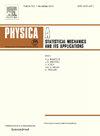Dynamic heterogeneities in stock markets
IF 2.8
3区 物理与天体物理
Q2 PHYSICS, MULTIDISCIPLINARY
Physica A: Statistical Mechanics and its Applications
Pub Date : 2025-04-15
DOI:10.1016/j.physa.2025.130567
引用次数: 0
Abstract
The dynamics of the New York Stock Exchange during the past decade is studied using observables borrowed from the study of glass-forming liquids. Using the log-price as equivalent to the particle position, the density autocorrelation function is calculated, which shows a stretched exponential decay. The Kohlrausch law correctly describes the decay, and the dependencies of the stretching exponent and time-scale with the wavenumber follow the same trends as for supercooled liquids. The equivalent of the overlap correlation function is also calculated and analyzed. The dynamic heterogeneities are studied using the non-Gaussian parameter and the dynamic susceptibilities, calculated from both correlation functions. The dynamic susceptibility grows from zero at short times to describe a maximum in the same time scale as the decay of the corresponding correlation function, and decays back to zero for long times. Finally, we show that avalanches of all sizes are present in the system, mimicking critical behavior previously discussed in glasses.
股票市场的动态异质性
纽约证券交易所在过去十年的动态研究是利用从玻璃形成液体的研究中借来的可观察到的。使用对数价格作为等效粒子位置,计算密度自相关函数,显示拉伸指数衰减。Kohlrausch定律正确地描述了衰变,并且拉伸指数和时间尺度与波数的依赖关系遵循与过冷液体相同的趋势。对重叠相关函数的等价进行了计算和分析。利用非高斯参数和由两种相关函数计算的动态磁化率研究了动态非均匀性。动态磁化率在短时间内从零增长到与相应的相关函数衰减相同的时间尺度上的最大值,并在长时间内衰减回零。最后,我们证明了所有尺寸的雪崩都存在于系统中,模拟了之前在玻璃中讨论的临界行为。
本文章由计算机程序翻译,如有差异,请以英文原文为准。
求助全文
约1分钟内获得全文
求助全文
来源期刊
CiteScore
7.20
自引率
9.10%
发文量
852
审稿时长
6.6 months
期刊介绍:
Physica A: Statistical Mechanics and its Applications
Recognized by the European Physical Society
Physica A publishes research in the field of statistical mechanics and its applications.
Statistical mechanics sets out to explain the behaviour of macroscopic systems by studying the statistical properties of their microscopic constituents.
Applications of the techniques of statistical mechanics are widespread, and include: applications to physical systems such as solids, liquids and gases; applications to chemical and biological systems (colloids, interfaces, complex fluids, polymers and biopolymers, cell physics); and other interdisciplinary applications to for instance biological, economical and sociological systems.

 求助内容:
求助内容: 应助结果提醒方式:
应助结果提醒方式:


